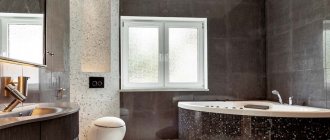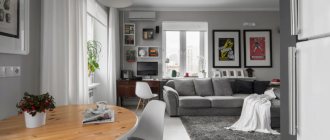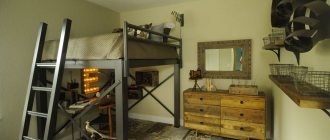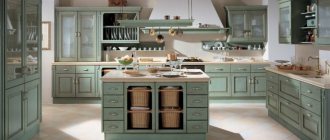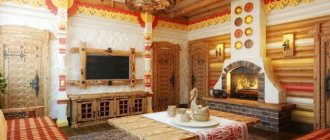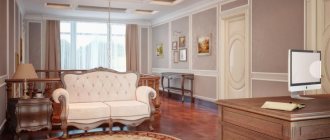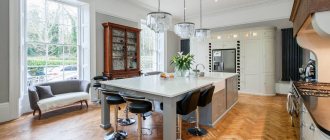The origins of Italian design date back to the Roman Empire: harmonious geometry, pleasing compositions. But the liveliness and love of life of Italians cannot leave them indifferent to luxury. This is confirmed by the breathtaking collections of Roberto Cavalli, Dolce and Gabbana, and other Italian designers.
The design of the Apennine Peninsula developed in two directions: the luxury of palazzos and palaces, its imitation in expensive urban housing, and the simple rustic style. Remembering the love of the Italian people for children and their reverence for family traditions, you understand that an Italian-style kitchen is always furnished with comfort. In addition, Italians are connoisseurs and lovers of delicious food; they spend a lot of time in the kitchen.
Characteristic features of an Italian style kitchen
- Focus on luxury and aesthetics.
- Predominance of natural materials.
- The presence of a spacious kitchen unit.
- Active use of decor, frescoes, mosaic panels, paintings.
- Warm colors.
- The organization of the interior is in the Italian style of sweet negligence, which gives it a special charm and comfort.
Finishing materials for kitchens in Italian style
To decorate the kitchen, natural materials are used - wood and stone . Wooden countertops go harmoniously with stone tiles and vice versa. They emphasize the status of the interior, making it elegant and stylish. However, natural finishes are expensive and require special care. Because of this, natural stone is replaced with artificial stone, and wood with MDF boards.
Ceiling finishing
The ceiling is whitewashed or finished with wooden beams, decorated with frescoes or paintings.
A small kitchen with a ceiling height of less than 3 meters is painted with water-based paint with a matte effect, after leveling the ceiling.
Painting is used in certain places. The ornament at the base of the chandelier or in the corners looks beautiful.
Decorative beams serve as a bright accent and give the kitchen expressiveness. Italian-style lamps are installed between the beams. They also use decor made of plaster or polyurethane - friezes, stucco molding, cornices.
Important! To decorate the ceiling in spacious kitchens, it is recommended to use volumetric decor.
Floor finishing
The floor should feel pleasant to the touch. To finish it, use stone or concrete tiles . This option looks simple and tasteful. To prevent the floor from being cold, a heating system is thought out in advance. Another flooring material is wood.
For luxury interiors, oak parquet is chosen, which is durable and reliable. For more budget kitchens, purchase laminate or linoleum with a wood effect. The shade of the floor should be combined with similar shades of decor or textiles.
Wall decoration
The color and structure of the walls emphasize the advantages of the kitchen and hide its shortcomings. For Italian interior use :
- Venetian plaster . It shines delicately and creates a pearl shimmer effect.
- Travertino plaster . The composition based on sand and marble creates a noble matte finish with an imitation of natural aged stone.
- Decorative painting helps create relief on the walls and hide imperfections - scratches and cracks.
- Non-woven wallpaper with a moisture-resistant coating. One of the most affordable materials is easy to apply and care for. It is recommended to purchase canvases from limited Italian collections.
To decorate kitchen walls in the style of a Tuscan or Mediterranean traditional home, choose textured colored plaster or paint with a matte finish . Natural colors are suitable for creating a cozy atmosphere and serve as a harmonious backdrop for wooden furniture and ceramic decor.
The basis of Italian style
Despite the apparent carelessness, the style of the sunny country, which is also called Tuscan, is thought out to the smallest detail: it seems that everything is arranged, hung, but every thing has its own meaning and stands in its place.
With external rustic simplicity, everything when creating the design of an Italian kitchen is subordinated to a common meaning, a single harmony.
Kitchen decor combines elements of everyday life and the environment. The Italian direction of ethno-style is characterized by increased comfort, which attracts kitchen owners. If they enjoy their surroundings, the food tastes better.
Distinctive features of the Italian style: correctly selected colors, emphasis on furniture, correctly selected decorative items.
The unity of the three components will create a harmonious, ergonomic and stylish space.
Italy is a country that honors family traditions, which is why the interior often displays a certain layering, when each generation brings something of its own, so the style allows for the use of rustic finishes in the decoration, and a mosaic panel appearing next to the rough plaster. Blurriness and wear will only complete the stylization.
Finishing
Italy gave the world a wonderful Art Deco style. By decorating a kitchen in this style, Italians demonstrate their taste, love for luxury and true classics. They use natural stone and ceramic tiles, textured wallpaper, and expensive wood. The furniture is also of the highest quality, made from solid wood.
Traditional Italian kitchen design. The drawers are convenient for storing all kinds of kitchen items. The tiles on the apron are matched to the decor of the hood.
Classic interior of Italian cuisine
Classical features in the interior of Italian cuisine date back to the era of antiquity. When talking about classical design, one cannot fail to mention such trends as Baroque, Rococo, Biedermeier or Empire.
Despite the fact that these are different styles, they have something in common - the desire for wealth and luxury. Indeed, the classics “scream” with their “palace” luxury, scope and deliberate pomp.
To decorate a room in a classic Italian style, you should focus on bulky and chic furniture made of wood with elements of gilding and velvet.
Renaissance paintings framed with ornate baguettes, candelabras, and bohemian chandeliers have characteristic features of this trend.
When decorating a classic Italian kitchen, it is also important to adhere to balance, correct forms and symmetry. Despite the bulky and luxurious fittings, there should be no unnecessary items in the room. The design of a classic kitchen combines nobility, grandeur, regularity and high cost.
Characteristic features are the stucco ceiling and walls.
Most often, sculptures are used as an accessory. This direction is rich in various half-columns, columns and moldings. You can also find order decor framing door openings. The arch between the kitchen and dining room looks very stylish.
The classic direction of the Italian kitchen interior embodies grace and moderation, but in no way pretentiousness.
Decoration Materials
The choice of finish depends on whether the kitchen is designed in the style of an Italian village or whether it is a design in the style of the home of a wealthy Tuscan or Sicilian aristocrat.
In any case, no plastic is allowed. It is also not recommended to decorate walls with wallpaper. Preference should be given to plaster, stone and ceramic tiles. The latter has no alternative when it comes to finishing the floor, as well as the apron. Moreover, it is necessary to choose tiles with Mediterranean patterns.
Modern interior of Italian cuisine
This direction is completely different, because not a trace remains of classical pomp. Modern trends bring new styles, for example, modern, neoclassical, art deco and others. However, the very authenticity of the spirit of Italy is preserved, adapting to modern design.
The sophisticated and luxurious elements of classic interiors are replaced by the sophisticated and graceful lines of modern Italian style.
You can recreate it in your kitchen, knowing the main features of the Italian interior:
- Use of environmentally friendly materials. In the modern world, the fashion for eco-products has also affected interior design. Therefore, the materials used for Italian cuisine must be natural, for example, wood painted in a dark color or natural stones.
Marble or granite are often used.
- Forged items look very stylish. These could be candlesticks, small lamps, kitchen table legs, etc. Such products will add grace and moderation to the room.
- Lighting is an important thing when decorating an Italian kitchen in a modern style. Since the room requires as much light as possible, a baroque crystal chandelier in the center of the ceiling, as well as forged candlesticks, would be appropriate. These light sources can generally convey the spirit of modernity and make the room more comfortable.
Since Italy is a sunny country, modern kitchen style includes only warm shades.
The color range varies from ivory to pastel, white, beige, and cream tones. However, there are rich and bright colors inherent in the Mediterranean style. Thanks to the natural and geographical features of the Mediterranean, the Italian kitchen interior “comes to life” in a new way, as the color palette is filled with bright yellow, green and blue tones.
Many accessories bring life to the kitchen room. Living plants in pots and vases, curtains both plain and multi-colored, various paintings, etc., will not be out of place on the windowsills.
Why choose this design
Italian style is popular as it reflects the main trends in modern interior design. For example, such design is carried out using mainly natural finishing materials. In addition, it involves hiding household appliances behind furniture facades.
At the same time, an Italian-style kitchen should be decorated with vintage decorative items or ceramic dishes. This cannot but please opponents of the minimalist trend in the field of modern interior design.
Italian style furniture
It is difficult to imagine an interior without furniture, so it is clear why it is often chosen before finishing. It rarely acts as a background, especially in this design direction. Here the headset sets the tone.
Italian-style furniture has classic features - carved facades, decorated with moldings, imitation columns, and floral motifs.
Such sets are often made for the ceiling, complemented by skirting boards, decorated corners, etc. Although many parameters will be different, usually the headsets are made of natural wood. Usually these are quite expensive varieties that look exceptional even without painting.
More affordable breeds are best used with additional finishing, especially since stylish Italian interiors are often painted in a wide range of shades.
In general, the furniture in such a kitchen will have antique features - classic, traditional, monumental, but still temperamental thanks to the color. The set can be specially aged, covered with craquelure varnish or patina.
If you are decorating the kitchen in a simpler rustic interior, then the space should include a dining table - large, wooden, without painting or excessive decoration.
For an ordinary Italian family, there will be benches next to it, albeit with backs - for comfort. In a more expensive setting, in which more classic touches can be seen, it is better to move the dining room into a separate room.
Tips for decorating an Italian-style kitchen
Let's consider some generally accepted rules that are used when decorating a kitchen in the Italian style. Classic style - symbolizes wealth and refined taste. It is very important that the kitchen interior is in harmony with the rest of the rooms. Didn't stray from the general line. Modern is for modern people who keep up with the times. It is typical for modern style for the housewife to have everything at her fingertips. Many different shelves and drawers. The presence of modern technology is characteristic of these styles.
Now for the finishing materials:
- Walls: wallpaper for painting, textured plaster, textile coverings are suitable.
- Floor: ceramic tiles, laminate. Laminate is considered the most budget option, but ceramics will add practicality to the kitchen.
- Ceiling: should contain bright lamps and be austere. The ceiling is best done in noble colors.
Italian kitchen in a classic modern style
An additional decoration for the kitchen will be crystal dishes and painted porcelain - this is what Italian cuisines are famous for. The Italian style contains a minimal amount of fresh flowers. An ordinary tulle curtain that will let light into the room will fit perfectly into the overall interior. Sometimes fabric folds and tassels are replaced with Roman blinds.
The Italian style of kitchen design enchants, delights, and allows you to feel the comfort and coziness of your home. It combines simplicity, lightness and harmony of all elements at the same time. Using these tips, you can give your kitchen special beauty and sophistication. Experience the Italian Renaissance with Italian furniture and accessories made in a traditional style.
Italian cuisine space
Usually this is a large kitchen, a huge area of which is dedicated specifically to the working area. In old Italian houses, the dining room is usually moved to another room. Maintaining family traditions does not allow you to refuse to eat together.
However, preparing dinner for the family is one of the housewife’s favorite pastimes, so she should be given enough freedom.
Italian style in the kitchen interior involves a lot of functional furniture. As a rule, this is an island set. The main part can be represented by any convenient option - corner, U-shaped, straight or parallel furniture. The choice of kit depends on the shape and area of the room.
There may be a small area for eating - for a morning cup of coffee, for a glass of wine during a friend’s visit, for an afternoon snack for a toddler who has come home from school while mom is preparing dinner.
Most often this is a part of the island that serves as a bar counter. Such an area near the window looks luxurious - then the window sill will play this role. Although there may also be a desktop here.
Needless to say, the easiest way to organize such a comfortable and sunny space is within the walls of a private home. Here you can plan it even at the construction stage. In an apartment, most likely, you will have to combine rooms.
An Italian-style kitchen-living room will be a little different than just a kitchen block.
It is imperative to arrange a dining area. And the dining group will, perhaps, take the leading role in the interior - just like in the classic style, where family lunches and dinners are a real ritual and tradition passed on from generation to generation.
Flooring - keeping up with the times
Despite the abundance of materials that successfully imitate natural wood or stone - for example, laminated parquet, it is unlikely to be able to convey the true spirit of Italy. For Italian-style kitchen design, plank floors with a pronounced and emphasized wood texture are more suitable. Depending on the chosen color scheme of the kitchen, you can use various glazing compounds for wood, which will not only protect it from moisture and dirt, but also give the desired shade and emphasize the natural structure.
Another obvious flooring option is natural stone, such as marble. In practice, decorating a kitchen with natural stone in a modern apartment is quite difficult. Therefore, in the interior of an Italian-style kitchen, you can increasingly find ceramic tiles or porcelain stoneware, which are much easier to work with, and this material has no less possibilities for decoration.
Thus, unpolished porcelain stoneware looks no less impressive than natural marble, but it is much easier to work with, and the cost of such a solution will be more acceptable. If the kitchen in which you plan to create an Italian style is massive in size, seamless tiles that do not have a chamfer will look chic. Such tiles allow you to create a monolithic covering, which will certainly become the “highlight” of the new room. A floor made of tiles or porcelain stoneware has another advantage - the possibility of pre-installing a heating system (“warm floor”), which can be either water or electric.
Accessories for luxury Italian style
To create Italian chic, interior designers actively use various accessories:
- • Hand-painted clay vases, bottles entwined with threads, transparent containers for bulk products on special shelves, small jars for seasonings on carved wooden stands.
- • A large number of pictures and decorative plates on the walls, sconces, figurines, candlesticks.
- • Wicker dishes, baskets, drawers for cutlery, openwork tablecloths.
- • Panels on the wall with landscapes or still lifes look very interesting. The panel is placed both above the tabletop and as an independent interior object on the wall. Images of the beauties of Italy and blooming vineyards will look great.
It is important to maintain the general style and color scheme of the interior so that the panel does not look like a foreign element.
With the help of accessories, the effect of slight negligence and special home comfort is achieved, which is characteristic of the Italian style. If it is preferable to choose furniture in warm, soft shades, then here you can experiment with small details and add rich colors.
Most often, decorative elements are brought directly from Italy along with the unusual atmosphere of this colorful country.
Characteristics
- Focus on luxury and aesthetics.
- Predominance of natural materials.
- The presence of a spacious kitchen unit.
- Active use of decor, frescoes, mosaic panels, paintings.
- Warm colors.
- The organization of the interior is in the Italian style of sweet negligence, which gives it a special charm and comfort.
Lightweight linen or cotton fabrics are suitable for window decoration.
Curtain colors are selected from natural shades
Windows are often left without curtains or blinds are used.
Ceiling, walls, floor
Parquet or laminate, tiles are often used as flooring; to divide the kitchen into zones, it is possible to use two materials together. If the floor may not be monochromatic and have some kind of ornament or pattern, then the walls should be made in one color. Since the main element in an Italian-style kitchen is furniture, the walls will only be a background for it.
Plaster looks very interesting, but you can limit yourself to a more affordable option - painting.
Designers suggest simply painting or plastering the ceiling in classic white, but not snow-white with a blue tint. You can add texture to the surface. If the space of the room allows, special wooden beams on the ceiling or walls, painted in a dark color, will look especially “Italian”.
Stretch ceilings and shiny surfaces should not be used, as well as boxes and multi-tiered structures. Like the walls, the ceiling is just a backdrop for exquisite furniture and decorative elements.
Wall decoration – don’t be afraid to experiment
The natural motifs of the Italian-style kitchen, in many ways, continue on its walls. The decoration of the walls here is not subject to strict rules; preference is given to any motifs and textures that can be found in nature. The most common ways to decorate walls are:
- decorative plaster;
- textured paint;
- finishing with artificial stone imitating old, crumbling walls in places;
- treated brickwork;
- frescoes, including mosaics.
Textile inserts on the walls look quite appropriate in an Italian-style kitchen; in addition, you can use genuine leather or metal. When using metal, you should take into account the fact that the Italian style implies the absence of shiny, polished metal surfaces, so you should give preference to matte or dark elements, of which there should not be too many.
If you don’t want to “mess around” with decorating the walls, especially when doing your own repairs, simple painting with water-dispersion compounds is quite acceptable. At the same time, the chosen color should, if not continue the main color scheme of the kitchen, then at least be combined with it. Since an Italian-style kitchen interior cannot do without an impressive number of accessories, this can also be taken into account when painting the walls. Plain walls can be easily made more “alive” by simply painting the walls with patterns (you can use stencils).
Features of selection of household appliances
When decorating a kitchen in Italian style, designers prefer to hide household appliances behind the façade in special niches. Modern technology is a foreign detail for this style. If it is not possible to disguise, then select appliances with antique-style elements, for example, gas stove handles with monograms or made of wood-look material.
The best solution would be built-in household appliances; in this case, the set itself is ordered according to individual sizes, taking into account the characteristics of the room.
Household appliances and furniture
Italian style furniture looks stylish and luxurious. Characteristic features are pretentiousness, volume, and the presence of small details. For furnishings, it is recommended to purchase :
- Corner set . In spacious rooms they use blue, green, honey, terracotta. An Italian-style kitchen for a small room should be white or light blue. Worktops are made of natural stone, granite or marble. Pretentious handles and open shelves for decorative items are a must. Upper cabinets with glass fronts and doors with mosaics or paintings are welcome. High-quality Italian furniture is made from natural wood.
- Dining group , which consists of a large oval table and soft chairs with high backs. The dining group is placed near the window or in the center of the room. The furniture is made of wood, matching the color with the kitchen set.
- Buffets, chests of drawers and other antique pieces of furniture are often found in Italian kitchens . They store kitchen textiles or dishes.
In order not to spoil the impression of the sophistication of the interior, large household appliances are hidden behind kitchen facades . To do this, measure the dimensions in advance and order custom-made furniture.
There is another option - purchasing stylized designer equipment, which in its appearance fits into the overall interior. Such models are produced by SMEG, Indesit, Samsung.
Italian style: history of origin
Whatever one may say, Italy has always been famous for its craftsmen and was considered a trendsetter. The exquisite creations of Italian designers delighted the whole world, from new clothing collections to interior items.
Anyone who has visited Italy once will definitely want to return there again.
This country has a lot of interesting things - narrow streets, delicious dishes, old squares, as well as melodic Italian speech. This is all the ardent, original and bright Italy. These are the features that the Italian interior has incorporated.
Oddly enough, it was in Italy that the word “design” originated in the 16th century. However, its essence differed significantly from the modern interpretation. At that time, design was the concept of a future work, which was developed by its creator.
Design in its modern understanding, as an activity of artistic construction, began to be used thanks to the work of such Italian masters as Gio Ponti, Gaetano Pesce, Ettore Sociss and others.
The room, made in Italian style, combines such incompatible things that it makes a strong impression on any visitor. Thus, palace chic and provincial simplicity, indestructible traditions and modern spirit create an incredible atmosphere of the Italian interior.
Just like the speech of Italians, which has a large number of dialects and dialects, there are many directions in this style.
For example, “trattoria” is a style for decorating a kitchen, reminiscent of a small cafe in Italy. It is characterized by wicker baskets for bread, a red and white checkered tablecloth on the table, clay pots and jugs with fresh and dried flowers, as well as bottles filled with wine and olive oil.
Having gone through many years of history, the Italian style has absorbed various features.
To decorate your room and preserve the true spirit of Italy in it, you can combine various options. This includes wood and natural stone for flooring, ornate furniture and a multi-level ceiling.
Due to the variety of interior solutions, you can understand the history of the development of the Italian style in the kitchen interior. There are classic and modern styles, which have their own features and characteristics, which will be discussed a little later.
If you are a fan of Italian style, then you have extraordinary taste. The following information will help transform an ordinary kitchen into a sophisticated and chic space.
Features of the Italian style
Like many other trends, the Italian style arose not in luxurious palaces, but in ordinary villages. Due to the favorable geographical location of the main region in which the style originated - Tuscany, its residents had the opportunity to decorate their houses with natural materials. Moreover, among them there were rare varieties of marble. This is where the fashion for using natural finishes in Italian-style rooms came from. This is most often wood or stone. The use of glass and metal is possible, but there are much fewer of them here. This design allows you to maintain harmony in the interior and give it a slight negligence.
At first glance, it seems that the interior is simply overflowing with various decorative components. But it is worth noting that all elements, even the most insignificant ones, have their own function and are used in the room for a reason. In addition, they are all a reflection of nationality. So, it turns out that the Italian interior in the kitchen has a touch of slight negligence, which is why many people fell in love with it.
The main emphasis in an Italian style kitchen is the furniture. It is made only from valuable wood and comes in a variety of colors. Both dark and light headsets can be used here. The choice depends on the idea of the interior.
Since this style is elegant, do not forget about maintaining the elegance of lines and shapes. But it is worth remembering that the external beauty of the interior of an Italian kitchen will never interfere with its functionality. Not only harmonious, but also slightly rough finishes of furniture and accessories are appropriate here.
The specific color palette of the style is what catches the attention of those who first enter such a kitchen. In this room, a large role is given to bright, saturated shades of natural orientation. There should be a lot of color in Italian cuisine, so combining different shades with each other is allowed.
Color solution
The color palette in which a kitchen in the style of sunny Italy is usually decorated is sometimes called bright. This is not entirely true; not bright, but rich, rich shades, close to natural, should emphasize the style of the kitchen space.
Palette
To decorate an Italian interior, choose colors:
- Olive;
- Grassy;
- Terracotta;
- Honey;
- Wine;
- Mustard;
- Orange.
The color scheme will depend on the overall design solution. Light furniture is acceptable - beige, milky, light olive and other colors against the background of more saturated shades of wall decoration.
Options for dark, deep colors of furniture against light walls are also possible.
Combinations
You can combine all shades in different ways, because the main thing in Italian cuisine is color and light. Rich natural colors - brown, ocher, pistachio, wine red - ideally combined with beige, peach, white, cream colors.
Sky blue, ivory, light orange shades complement and dilute the rich colors, resulting in a harmonious relationship that creates a homely, cozy atmosphere.
Important! The Italian style does not allow white color in interior design - neither when decorating a room, nor for furniture. Only occasionally it is found in decorative elements.
Italian cuisine can be made either in a single color scheme using several shades of the same paint , or in contrasting colors:
- Light olive color of the walls and rich grassy green shade of the furniture;
- Coffee shade when decorating the walls, dark brown color of cabinets and countertops;
- Light sand, combined with olive, pistachio;
- Sandy, combined with the deep, rich color of red wine.
Italian style bathroom
The Italian bathroom borders on the Baroque and Morroco styles: luxury in simple things, decoration in gold or white tones:
- round or oval bathtub, if the family budget allows - you can choose a model with hydromassage, large in size;
- A white bathroom with golden legs will look beautiful;
- necessarily a forged wall mirror;
- cabinets can be chosen in a classic style, white;
- cover the walls with a beautiful fresco, marble, mosaic panels, plaster or paint.
An example of bathroom design Source www.keramogranit.ru
Suitable colors: silver, delicate beige, luxurious gold, harmonious white.
Design in gray Source www.picuki.com
There is not always enough space in the bathroom to place many shelves and cabinets. The main thing in decorating a room is the appropriate arrangement of furniture, the right solution for free space.
Azure tiles Source sanroom.by
You can put a warm fleecy rug on the floor or install a heated floor system if you choose natural stone tiles.
Finishing materials
The closeness to nature that distinguishes the Italian style in the kitchen interior is expressed not only in the choice of color, but also in the materials used to decorate the walls, ceiling and floor of the kitchen.
Walls
Italy loves space, so the style suggests that there should be a lot of space in the kitchen. Then natural materials would be appropriate here:
- Wood, and it may not be planed;
- Stone (marble and others).
The materials can be anything, except for cheap-looking colorful wallpaper; it is better to choose plain coatings for the walls - this can be painting, decorative plaster, painted wallpaper and others. Ceramic tiles can be used in warm colors: sand, olive.
Mosaic panels will fit harmoniously into the decoration of the walls. Multi-colored stained glass windows are appropriate on walls, doors, ceilings, and kitchen furniture doors.
Important! No plastic is allowed in an Italian-style kitchen. Doors, window frames, window sills - only wood.
Floor
It is better to leave the floor wooden. The flooring must be able to withstand the weight of massive furniture. You can choose parquet or porcelain slabs under which to install a heating system: Italian style does not imply carpeting the floors.
Ceiling
It is better to leave beams on the ceiling that are painted with dark paint or that have retained the natural color of the wood. If the height allows, stucco molding, plaster moldings, and ceiling painting can be used.
If the height of the room is small, make suspended ceilings to match the walls. You can choose a mirrored ceiling, which visually increases its height.
Materials are an important component of style
Any Italian-style kitchen is an oasis of natural materials and the same colors. Natural or artificial stone, metal, valuable wood, natural textures, which are not customary to hide. This makes it easy to achieve the impression that the newly finished kitchen has been passed down from generation to generation for years. To a large extent, this is facilitated by correctly selected colors and textures.
Thus, the design of a kitchen in the Italian style often involves the use of decorative plaster for wall decoration, various variations of which allow you to create a unique, unique design that will simply be impossible to repeat. When planning the interior yourself, you should understand that all natural materials absorb water quite well. It follows that they need to be protected - especially wood.
To do this, you should use special bioprotective compounds that are colorless and odorless, but have excellent characteristics in terms of protection against rotting and mold formation. Well-chosen colors enhance the “natural” motifs of the room. At the same time, an Italian-style kitchen allows for color combinations - the main thing is that they match each other.
Who is an Italian-style kitchen suitable for?
This style simply worships the cult of family. This is a room in the house where you just want to gather around a large table with the whole family or in a noisy group of friends. Each family member will find their favorite area, a piece of themselves, here.
Therefore, the interior in the Italian style is very multifunctional: it has a dining area for meals and get-togethers, a bar counter for personal meetings, romantic conversations, and a huge work surface where any woman will feel like a full-fledged mistress of the house.
A traditional Italian-style kitchen requires a comfortable seating area with a minibar or a “down-to-earth” comfortable table. This is a “male” territory in the interior. This is a place for business negotiations, gambling, smoking cigars and wine tasting.
Furniture is the most important part of an Italian-style kitchen interior
One of the important elements of an Italian-style kitchen is furniture. As a rule, this is massive, high-quality furniture made from solid wood. This style does not “welcome” smooth or curved lines - ideally, furniture should be simple, with straight fronts and massive straight tabletops. One of the main pieces of kitchen furniture is the table at which the whole family gathers - ideally it should be massive and have an elongated shape.
The desktop top is not necessarily made of wood, which is difficult to maintain, since the Italian style is not without practicality. The work area, as a rule, is designed using natural or artificial stone, which is completely easy to care for. Much attention is paid to a variety of wall cabinets - in addition to closed ones, open designs, or simply wall shelves, are welcome. It is worth remembering that the interior of an Italian-style kitchen implies a certain “creative disorder”, so you should not hide all the kitchen utensils.
Lighting Features
Everything should be in harmony when decorating Italian cuisine. And if the table, cabinets, chairs actively use artistic forging, then this idea is accurately repeated when choosing lighting.
Therefore, a massive and luxurious chandelier with a forged metal base must be present. This chandelier will determine the center of the room where the dining group will be located.
Lighting should be multi-zonal. You need to use both wall sconces and retro-style spotlights, which will be located above the work area and apron. Thanks to this technique, the ceiling and walls will be illuminated with soft, diffused light.
If you have a soft corner, then a Tiffany-style table lamp will fit well in this part of the room.
Who is it suitable for?
This style simply worships the cult of family. This is a room in the house where you just want to gather around a large table with the whole family or in a noisy group of friends. Each family member will find their favorite area, a piece of themselves, here. Therefore, the interior in the Italian style is very multifunctional: it has a dining area for meals and get-togethers, a bar counter for personal meetings, romantic conversations, and a huge work surface where any woman will feel like a full-fledged mistress of the house.
An Italian-style kitchen always looks elegant and luxurious, fully reflecting the traditions of Italy
Here palace luxury merges with cozy country
A traditional Italian-style kitchen requires a comfortable seating area with a minibar or a “down-to-earth” comfortable table. This is a “male” territory in the interior. This is a place for business negotiations, gambling, smoking cigars and wine tasting.
Interesting solutions
Why does an Italian-style kitchen look so cozy, family-friendly, but at the same time respectable? Let's look at 5 popular design techniques:
- As you have already noticed, an Italian-style interior requires maximum closeness to natural colors and textures. Therefore, the kitchen apron should also be laid with tiles or mosaics that repeat the pattern of granite and stone. Tabletops for the work area are selected using the same principle.
- The walls and even the ceiling are generously decorated with frescoes and mosaic designs. This can be either artistic painting of the surface or its imitation. For example, photo wallpapers depicting the faces of saints and mythological characters. You can also order the production of paintings on canvas, which will be duplicates of famous works by Italian artists.
- Arched shapes in the kitchen interior. The atmosphere really feels like staying in a villa. And there they very often use arched openings for doors and windows. All this adds intimacy and respectability to the interior.
- Use decor in your interior more actively. The ideal option would be if these beautiful little things were brought from Italy itself. What could it be? Souvenir plates, painted amphorae, bottles of wine in wicker baskets, forged candlesticks with the effect of aged metal.
- Using textures and a palette of colors that give a glow. For example, natural stone gives a beautiful shine. Italian-style furniture often lends itself to finishing gilding. Forging can have a bronze patina. All this makes Italian cuisine look luxurious.
Italian style kitchen color scheme
Italian style is divided into several directions : Tuscan, Mediterranean, modern. The choice of color scheme depends on this:
- Tuscan-style kitchens are characterized by natural colors. Combined with wooden furniture, stone tiles and ceramic tableware, they create the atmosphere of a traditional family home. Popular shades are beige, ecru, ocher, terracotta, olive, and saffron. They are used for finishing walls and ceilings. This color scheme is reminiscent of the colors of the Art Nouveau style.
- Modern Italian style includes shades of burgundy, emerald, turquoise, white, and aquamarine. For small kitchens, light colors are used, as they visually increase the space.
- Mediterranean style (pictured below) is sandy, terracotta, yellow, olive, red. The blue color stands out separately - it symbolizes the sky and sea, and is used as a background or accent color.
To create a harmonious and cozy interior, choose one main color and several additional ones . For example, the combination of white with wine and emerald shades is popular. Combine colors in any proportions.
It can be useful:
Current design and interior of modern kitchens
Kitchen under the stairs to the second floor in a private house
Kitchen design in a classic style
Decoration of window openings
An Italian-style kitchen cannot have plastic windows. If for some reason it is impossible to install wooden ones, choose wood-look options.
You can decorate a window opening with curtains with a simple design, without lambrequins or complex draperies. It is better to choose light colors.
Stage three - decoration and design
An Italian-style interior is characterized by a certain creative disorder. Carved furniture is attractive, but Italians prefer to keep kitchen utensils in plain sight. They are placed on shelves or hung on hooks.
Emphasize the atmosphere of Italian cuisine with the help of an embroidered tablecloth, pillows and patchwork with pictures with national motifs.
WATCH THE VIDEO
Beautiful bottles of olive oil, jars for spices, and fruit in wicker baskets will help revive the interior. Don't forget to place lots of clay pots with live plants and vases of flowers. Hang bunches of dried plants and bunches of onions around the kitchen. This way you will surprise your guests and introduce elements of Italian interior design into the kitchen. This is what an Italian style kitchen is like.
Reliable finishing materials
One of the main trends in Italian kitchen interior design is the use of only high-quality and durable finishing materials with pronounced natural motifs. They can be either natural or artificial, but always with a noticeable authentic texture.
Among the most common kitchen design options:
- Walls - decorative plaster, ceramic tiles, textured plain wallpaper, brickwork, frescoes, mosaics, textured paint, artificial stone. Textiles and leather can be used as decorative inserts.
- Ceiling – textured plaster, clay, false beams, gypsum moldings.
- Flooring – matte natural or artificial stone, plank flooring, stained wood, ceramic tiles.
- Apron - porcelain stoneware, fine mosaic, white or red clay.
Important! The Italian style does not accept a large number of polished shiny surfaces, so metal, plastic and glass should not be used in the first roles in the kitchen.
Natural color solutions
Italian style gravitates towards natural shades that are found in the environment of the sunny Mediterranean. Numerous photos of kitchen interiors demonstrate the predominance of the following color schemes:
- derivatives of white - milky, ivory, snow-white;
- shades of brown - ocher, terracotta, wood, brick, red, mustard;
- fruit and berry – peach, cherry, grape, olive;
- shades of the surrounding nature - blue, sea, turquoise, grass, yellow, lavender, honey, sand, orange.
Advice. When choosing a color scheme for the kitchen, focus on the direction of the Italian style: a classic interior involves the abundant use of all shades of white and even snow-white tones interspersed with gold and various variations of wood, while modern trends are characterized by the active use of rich, juicy sea, fruit and floral tones.
A few more popular styles...
Along with classic kitchens, people often buy models in the “High-Tech”, “Modern” and “Country” styles. Italian kitchens made in the “Modern” style look progressive and fashionable. They are bought by people who are accustomed to being in the center of events and are sensitive to changes. Kitchens are characterized by the following features: the presence of smooth lines of facades and countertops, and at the same time the severity of forms, oval niches, glass elements, glossy surfaces, an abundance of bright colors, and the use of patterns. Modern style kitchens are made from both natural materials - solid wood, veneer, and artificial ones - plastic, MDF and others. The cost of furniture depends on the type of material. Cooking in such kitchens is a pleasure, since many household appliances can be built into the facades.
High-tech is a modern style in the interior that attracts young people with an active lifestyle with its simplicity and at the same time special charm. Kitchens of this style are characterized by the presence of strict lines on the facades, many glass doors, an abundance of colors, a minimum of decor, and a lack of an abundance of objects.
Kitchen in Hi Tech style
No wood is used in the manufacture of kitchens in this style. The main materials are acrylic, glass, aluminum and polycarbonate, thanks to which the furniture has almost ideal characteristics. It is fire resistant and not subject to slight mechanical damage.
Country is a rustic style that creates an atmosphere of calm and comfort in the interior of the room. Kitchen furniture is made of natural wood, painted in beige, white, walnut, sand and other natural colors. It is characterized by simplicity and smoothness of forms, lack of luxury, and romance. A country-style kitchen is ideal for relaxing and entertaining guests, and is chosen more often by people over 30, who are tired of gloss and gloss, and various innovations.
Country style kitchen
Design
Classic style kitchens are characterized by calm tones in colors: white, cream, brown, as well as the presence of carved and decorative elements on the facades, columns, arched niches, symmetrically located elements, stained glass windows with artistic design. Classic Italian kitchens have always been popular, and interest in them will never dry up, because they do not become outdated, they look elegant and luxurious. “Classic” symbolizes the wealth and refined taste of the owner.
Italian classic cuisine is always in fashion
Italian style kitchen: decoration, furniture and appliances
We can safely say that the interior of an Italian-style kitchen skillfully interweaves the chic of ancient culture and the simplicity of the rural way of life. Italians are life-loving people, so they do not remain indifferent to luxury, natural materials and rich finishes. But no less, they love comfort, honor family traditions and idolize the comfort of home. This symbiosis of two completely opposite directions allows you to create an extraordinary design of a kitchen space, where it is pleasant to create culinary masterpieces, receive compliments from friends about a delicious treat, or simply have a meal with your family. Let's decide what characteristic features are inherent in Italian cuisines?
- Elegance. Even the rough finish of a rustic kitchen does not spoil the elegant look of the room. What is it expressed in? In graceful lines and curved shapes, which are visible in furniture and decoration. Calm colors also contribute to the formation of a sophisticated interior.
- Naturalness of finishing materials. Taking all the best from country style, Italian-style kitchen design is filled with natural finishing materials - natural stone, wood, ceramic tiles. Metal and glass are also present in small quantities, but do not predominate in the interior. Instead, an atmosphere of comfort, calm and steadfastness is created by cute trinkets made from natural materials with your own hands, mosaic panels, stone floors, rough wooden beams and solid wood furniture.
- Wooden furniture. We can say that this is the basis of the Italian style. A good quality kitchen set is taken as the basis when decorating a kitchen in this style. It must be made of natural wood of valuable species and can be decorated with decorative carvings. This is exactly the case when a buffet would be appropriate in the kitchen, containing all the necessary utensils for a long meal, as well as a massive dining table that can withstand the weight of all the dishes and treats.
Kitchens in Italian style Provence photo
- Kitchen appliances. Naturally, modern technology makes the cook’s work easier, and it’s not easy to give it up. Therefore, the Italians willingly let her into their territory. The only nuance that can be noted here concerns the color of large household appliances - metallic-colored appliances will look best together with natural finishing materials and wooden furniture. The same applies to furniture fittings.
Above we described the main components of an Italian-style kitchen. Next, let's look at the interior of such a kitchen in more detail. In the meantime, we invite you to familiarize yourself with the design options for Italian kitchens presented in this video.
Bella Donna: what an Italian-style kitchen looks like ↑
She's easy to recognize. Coverings for facades and walls are wood in rich and deep tones. It goes well with terracotta or dark blue tiles on the wall and parquet boards on the floor. Kitchen furniture in Italian style is style, style, and more style. Italian craftsmen make everything unique, elegant and refined. This even applies to factory-made furniture, which is designed for the mass consumer.
An Italian-style kitchen is characterized by a contrasting combination of colors, effectively set off by bright natural lighting.
Do you want to equip an Italian-style kitchen in your apartment? You don't have to retile your kitchen or redo your flooring. It is enough to include recognizable elements in the kitchen interior that will convey to visitors the idea of sunny Italy.
Lighting fixtures and accessories
As already mentioned, an Italian-style kitchen should be richly decorated. Let us immediately note that the amount of textiles should be minimal. In particular, the use of carpets is prohibited.
As for the lamps, antique metal chandeliers are suitable.
It is recommended to use antique household items as decorative items, for example, kerosene lamps, dishes, thick colored glass bottles, etc.
Indoor plants in small pots also look appropriate in an Italian interior.
Italian style kitchen interior: decorative elements
Of no small importance in the interior of Italian cuisine is given to other, smaller, but no less necessary details. We will talk about decor and accessories.
- Accessories. Italian-style kitchen decor is given special attention. This is not a case of putting all kitchen utensils and dishes out of sight. Quite the opposite - all the good stuff is put on display, everything is on display, from ladles, plates and cutting boards, to bunches of aromatic herbs and bunches of garlic near the stove. And also baskets of fruit, fresh flowers in vases, herbs growing right in pots, depictions of the animal and plant world in paintings and panels. The slight carelessness with which the decorative elements are arranged and hung charms and attracts even more.
Kitchen decor in Italian style photo
- Fireplace. A traditional element of a kitchen in the Italian Provence style is a symbol of home. In the modern world, it can be replaced with an electrical analogue.
- Apron. In the work area, an Italian-style kitchen apron is usually decorated with small square tiles. It can be not just a single-color tile, but a whole panel depicting, for example, a still life.
- Curtains and drapes. Translucent or thick curtains made of natural materials (linen, cotton), carefully framing the window, are not used to cover the window from casual glances. They serve solely for decoration.
Italian style kitchen photo
These are the details that will allow you to recreate a truly Italian spirit in the kitchen. The only thing we haven’t mentioned is the color scheme of the kitchen space. We'll talk about this further.
In Italian, or the basics of Italian cuisine
Agree, Italians are no longer so much the name of a nationality, but rather a set of distinctive character traits inherent in them.
So let’s try to look at these unique features of those living in Italy in order to understand what an Italian-style kitchen should be like.
More than anything else, Italians value peace and tranquility, family and traditions. Home, warmth, loved ones, comfort - this is a real hearth. Therefore, the kitchen is a kind of chronicle of generations, where the previous one leaves parting words to the next. And there is no blank slate in the interior!
Therefore, we will have to try to ensure that our Italian interior matches the original at least a little. A simple trick will help with this - we combine completely different finishing methods on the walls: we plaster one part with decorative plaster, cover another with bright tiles, paint the third several times, apply a mosaic cloth to the fourth or leave it wooden.
The Italians' love for the natural can be emphasized by choosing unprocessed natural materials as wall and floor coverings: stone or wood. Italian-style floors today are decorated with marbled tiles.
Of course, in Russia, when creating an interior in the Italian style, they most often use imitation of these natural materials, and try to give them an aged look.
For maximum effect in the kitchen decoration, use wooden beams painted in a dark color, and place different lamps between them. Attach bunches of dried vegetables and herbs to the beams - mandatory attributes of the Italian table.



